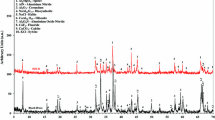Abstract
The use of alternative fuels and raw materials in cement industry leads to the incorporation of some undesirable compounds into the clinker phases. One of them is barium oxide which influences the formation of clinker phases and related properties of the produced cement. Barium in clinker was already studied; the phase composition is changed depending on the amount of barium. However, detailed research focused on hydration properties of these clinkers and cements has not been carried out, yet. A clinker with barium oxide addition to raw meal was prepared. As a source of barium oxide, barium sulphate (baryte) was used in amount of 4% calculated to BaO in the clinker. Barium incorporated in clinker inhibits formation of alite; therefore, lime saturation factor was slightly reduced. Compared to barium carbonate—another source of barium oxide—barium sulphate influences the ratio of clinker phases less significantly. This clinker and a reference sample without barium were milled with and without addition of gypsum. Hydration of barium clinker and cement was examined by XRD in situ hydration and isothermal calorimetry. Hydration products were evaluated by means of thermogravimetric and differential thermal analysis. An increase in total heat of hydration can be seen in samples with barium. The heat is influenced by different hydration of clinker phases with incorporated barium, sulphates and by higher content of free CaO and C3A. According to XRD in situ hydration, hydration of samples with barium is suppressed, the amount of portlandite during the whole measurement is much higher in samples without barium.








Similar content being viewed by others
References
Terezza MA, Scian AN. Burning wastes as an industrial resource: their effect on Portland cement clinker. Cem Concr Res. 2000;30:137–44.
Juel I, Jons E. The influence of earth alkalis on the mineralogy in a mineralized Portland cement clinker. Cem Concr Res. 2001;31:893–7.
Katyal NK, Ahluwalia SC, Parkash R. Effect of barium on the formation of tricalcium silicate. Cem Concr Res. 1999;23:1857–62.
Zezulova A, Stanek T, Opravil T. Influence of barium oxide additions on Portland clinker. Ceramics-Silikáty. 2017;1:2. https://doi.org/10.13168/cs.2016.0055.
Mu Y, Liu Z, Wang F, Huang X. The effect of barium doping on carbonation behaviour of γ-C2S. J CO2 Util. 2018; https://doi.org/10.1016/j.jcou.2018.08.018.
Chen L, Shen X, Ma S, Huang Y, Zhong B. Effect of barium oxide on the formation and coexistence of tricalcium silicate and calcium sulphoaluminate. J Wuhan Univ Technol Mater. 2009. https://doi.org/10.1007/s11595-009-3457-6.
Hewlett PC, editor. Lea’s chemistry of cement and concrete. 4th ed. Oxford: Elsevier; 2004.
Locher FW. Cement: principles of production and use. Düsseldorf: Bau Technik; 2006.
Udagava S, Urabe K, Yano T. Stabilization mechanism and polymorphism of Ca2SiO4. In: Review of the 34th general meeting in Tokyo: Cement Association of Japan. 1980. pp. 37–39.
Zhang P, Zhang S, Wang S, Liu H, Lu L, Cheng X. Effect of BaO on mineral structure and hydration behavior of phosphoaluminate cement. J Therm Anal Calorim. 2019. https://doi.org/10.1007/s10973-018-7890-7.
Zhang W, Wang S, Li S, Lu L, Cheng X. Effect of BaO on the calcination and hydration characteristic of CA. J Therm Anal Calorim. 2019. https://doi.org/10.1007/s10973-018-7795-5.
Madej D, Boris R. Synthesis, characterization and hydration analysis of Ba2+-, Cu2+- or Bi3+-doped CaO–Al2O3–ZrO2-based cements. J Therm Anal Calorim. 2019. https://doi.org/10.1007/s10973-019-08142-7.
Wang S, Liu B, Zhao P, Lu L, Cheng X. Effect of early-strength-enhancing agents on setting time and early mechanical strength of belite–barium calcium sulfoaluminate cement. J Therm Anal Calorim. 2018;1:2. https://doi.org/10.1007/s10973-017-6837-8.
Tashiro C, Yamada H, Akiba T, Nawata S. Study on the hydration of 2BaO·SiO2. Cem Concr Res. 1976;6:633–40.
Yanrong LSW, Chen L. Investigation on the formation of ettringite in the presence of BaO. Cem Concr Res. 1995;25:1417–22.
C 1356, Standard test method for quantitative determination of phases in Portland cement clinker by microscopical point-count procedure. ASTM International, United States. 2007.
Chromý S. Anfärben des freiem CaO und Silikate in anschliffen von Portlandklinker. Zement-Kalk-Gips. 1974;27:79–84.
Chromý S. Accuracy and precision of microscopic quantitative phase analysis of Portland clinkers. Silikáty. 1978;22:215–26 (in Czech).
Mitchell LD, Margeson JC. The effects of solvents on C–S–H as determined by thermal analysis. J Therm Anal Calorim. 2006;1:2. https://doi.org/10.1007/s10973-006-7712-1.
Gies A, Knöfel D. Influence of sulfur on the composition of belite-rich cement clinker and the technological properties of the resulting cement. Cem Concr Res. 1987;17:317–28.
Horkoss S, Lteif R, Rizk T. Influence of the clinker SO3 on the cement characteristics. Cem Concr Res. 2011. https://doi.org/10.1016/j.cemconres.2011.04.015.
Herfort D, Soerensen J, Coulthard E. Mineralogy of sulfate rich clinker and the potential for internal sulfate attack. World Cem. 1997;28(5):77–85.
Gallucci E, Mathur P, Scrivener KL. Microstructural development of early age hydration shells around cement grains. Cem Concr Res. 2010. https://doi.org/10.1016/j.cemconres.2009.09.015.
Palou MT, Kuzielova E, Novotny R, Soukal F, Zemlicka M. Blended cements consisting of Portland cement–slag–silica fume–metakaolin system. J Therm Anal Calorim. 2016. https://doi.org/10.1007/s10973-016-5399-5.
Shoude W, Cheng C, Lungchao L, Xin C. Effects of slag and limestone powder on the hydration and hardening process of alite-barium calcium sulphoaluminate cement. Constr Build Mater. 2012. https://doi.org/10.1016/j.conbuildmat.2012.03.004.
Acknowledgements
This research was done within the project No. 16-08959J financed by the Czech Science Foundation.
Author information
Authors and Affiliations
Corresponding author
Additional information
Publisher's Note
Springer Nature remains neutral with regard to jurisdictional claims in published maps and institutional affiliations.
Rights and permissions
About this article
Cite this article
Zezulová, A., Rybová, A. & Staněk, T. Hydration of clinkers doped with baryte with and without addition of gypsum. J Therm Anal Calorim 138, 1945–1952 (2019). https://doi.org/10.1007/s10973-019-08632-8
Received:
Accepted:
Published:
Issue Date:
DOI: https://doi.org/10.1007/s10973-019-08632-8




